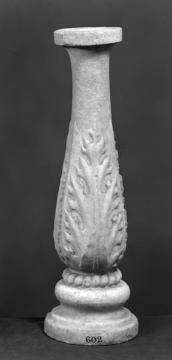Explore Collections


You are here:
CollectionsOnline
/
A Roman baluster or shaft, perhaps the centre and base of a candelabrum
Browse
Curatorial note
The bulging curve is enriched with double layer of acanthus-leaf sheathing rising from carved palm-leaf base on rope moulding. Filleted lip at top and turned pedestal below.
In Lehmann-Hartleben and Olsen, Dionysiac Sarcophagi in Baltimore, fig. 16, the centre parts of the baetyli between the griffins on the front of the sarcophagus with griffins are nearly identical with this section; only the lid(?) and the tetrapod, footed base are lacking in the Soane fragment to make the likeness more complete. In Michelangelo's Medici Chapel, San Lorenzo, Florence, identical ornaments from the central sections to the candelabra appear on either end of the altar dedicated by Pope Paul V in 1610 to the great Medici; these strictly Roman imperial (Second Century and onwards) decorative accessories have been copied in this sober Baroque work (even to imitation of the drill points in the carved acanthus foliage.
It is possible that this piece might have been the baluster of a balustrade, rather than part of a baetyli [suggestion by Jacqueline Thalmann]
In Lehmann-Hartleben and Olsen, Dionysiac Sarcophagi in Baltimore, fig. 16, the centre parts of the baetyli between the griffins on the front of the sarcophagus with griffins are nearly identical with this section; only the lid(?) and the tetrapod, footed base are lacking in the Soane fragment to make the likeness more complete. In Michelangelo's Medici Chapel, San Lorenzo, Florence, identical ornaments from the central sections to the candelabra appear on either end of the altar dedicated by Pope Paul V in 1610 to the great Medici; these strictly Roman imperial (Second Century and onwards) decorative accessories have been copied in this sober Baroque work (even to imitation of the drill points in the carved acanthus foliage.
It is possible that this piece might have been the baluster of a balustrade, rather than part of a baetyli [suggestion by Jacqueline Thalmann]
Rome; collected in Rome by Charles Heathcote Tatham for the architect Henry Holland during the 1790s. See Cornelius Vermeule, unpublished catalogue of the Antiquities at Sir John Soane's Museum, Introduction, transcription of Tatham letters, List 2, no.9.
Literature
Tatham: Drawings, 1.
Soane collections online is being continually updated. If you wish to find out more or if you have any further information about this object please contact us: worksofart@soane.org.uk


